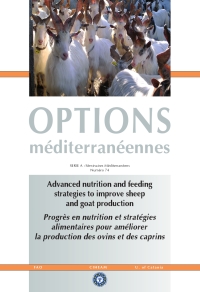| Article précédent | p. 395-398 | Article suivant |
Effect of propylene glycol addition to the diet of dairy ewes on metabolic profile, milk yield and quality
To study the effects of propylene glycol on metabolic profile and milk yield and quality during the 30 days prior to and 30 days after lambing, fifty one Valle del Belice dairy ewes were blocked by parity, bodycondition score, previous milk production, and assigned randomly to three groups: Control, Propylene glycol (PG): Low PG: 80 g per ewe per day and High PG: 160 g per ewe per day. During the prepartum period, the addition of 160 g ewe/d of PG caused a decrease (P<0.05) of plasma non-esterified fatty acids, while during the postpartum period propylene glycol increased (P<0.01) plasma glucose. During the prepartum period, plasma total cholesterol and LDL decreased (P<0.01) in ewes of Low PG and High PG groups, while after lambing, plasma urea decreased (P<0.01) in Low PG group. In comparison to control ewes, propylene glycol increased milk yield in Low PG group (+16%) and in High PG group (+25%; P<0.01). The addition of propylene glycol was also associated to a decrease (P<0.01) of milk urea and improved milk clotting time (P<0.05) and curd firmness (P<0.01).
Afin d'étudier les effets du propylène glycol sur le profil métabolique et la quantité et qualité du lait pendant les 30 jours avant et les 30 jours après la mise bas, 51 brebis laitières Valle del Belice ont été retenues d'après le numéro de mise bas, la note d'état corporel, la production laitière précédente, et distribuées au hasard dans trois groupes : Témoin, Propylène glycol (PG): Bas PG: 80 g par brebis et par jour et Haut PG: 160 g par brebis et par jour. Pendant la période prepartum, l'addition de 160 g de PG/brebis/j a entraîné une diminution (P<0,05) des acides gras non estérifiés plasmatiques, tandis que pendant la période postpartum le propylène glycol a entraîné une augmentation (P<0,01) du glucose plasmatique. Pendant la période prepartum, le cholestérol plasmatique total et les LDL ont baissé (P<0,01) chez les brebis des groupes à Bas PG et Haut PG, tandis qu'après la mise bas, l'urée plasmatique a baissé (P<0,01) chez le groupe Bas PG. En compaison aux brebis témoins, le propylène glycol a entraîné l'augmentation de la production de lait chez le groupe Bas PG (+16%) et le groupe Haut PG (+25%; P<0,01). L'addition de propylène glycol était également associée à une baisse (P<0,01) de l'urée du lait et améliorait le temps de coagulation du lait (P<0,05) et la fermeté du caillé (P<0,01).
- [ Afficher ]
- [ Télécharger ]
- [ Exporter la citation ]
Vous pouvez télécharger la citation au format :
- [ Imprimer ]
-
Mots-clés
ALCOOL, BREBIS, EXPERIMENTATION, LAIT, PRODUCTION LAITIERE, QUALITECiter cet article
Chiofalo V. Effect of propylene glycol addition to the diet of dairy ewes on metabolic profile, milk yield and quality. In : Priolo A. (ed.), Biondi L. (ed.), Ben Salem H. (ed.), Morand-Fehr P. (ed.). Advanced nutrition and feeding strategies to improve sheep and goat . Zaragoza : CIHEAM, 2007. p. 395-398. (Options Méditerranéennes : Série A. Séminaires Méditerranéens; n. 74). 11. Seminar of the FAO-CIHEAM Sub-Network on Sheep and Goat Nutrition, 2005/09/08-10, Catania (Italy). http://om.ciheam.org/om/pdf/a74/00800406.pdf



